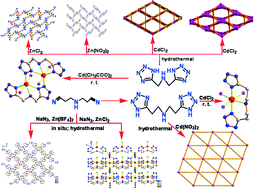The designed organic ligands bis-(1H-tetrazol-5-ylmethyl)-amine (H3L1) and bis-(1H-tetrazol-5-ylethyl)-amine (H3L2) have been successfully prepared and their coordination features have been explored. By the reaction of H3L1 and H3L2 with different zinc/cadmium salts, two 0D complexes, Cd2(HL1)2(H2O)4·2H2O (4) and Cd(HL2)(H2O)3 (8), and seven new coordination polymers, [Zn(HL1)(H2O)]n (1), [Zn(HL1)]n (2), [Cd3(HL1)2Cl2]n (3), {[Cd2(HL1)2]·H2O}n (5), [Zn(HL2)]n (6), [Zn2(HL2)N3Cl]n (7) and [Cd2(H2L2)(NO3)(OH)(H2O)2]n (9) have been synthesized. All the compounds were fully characterized by elemental analysis, IR spectroscopy, thermogravimetric analysis, powder X-ray diffraction and single-crystal X-ray diffraction. Complex 4 exhibits a dinuclear structure, whereas 8 represents a mononuclear structure. In addition, 4 and 8 are further assembled to form three-dimensional (3D) and two-dimensional (2D) supramolecular frameworks by hydrogen-bonding interactions, respectively. Complexes 1, 2, 6, 7 and 9 possess a 2D layered structure, and the 2D frameworks of complexes 1, 2 and 6 can be rationalized to be four-connected {44·62} topological sql networks with the dinuclear units, while 9 shows a two-dimensional six-connected {36·46·53} topological hxl network containing a [Cd4(OH)2(H2O)2(NO3)2] cluster. Complex 3 bearing the 3D framework can be rationalized to be a new {318·418·59} topological net with the stoichiometry (10-c). Complex 5 features the 3D topological tcj/hc structure of {36·46·53}{36·48·54·68·72} with the stoichiometry (6-c)(8-c). Both complexes 3 and 5 contain 1D channels with an accessible solvent volume of 38.8% and 12.1%, respectively. Obviously, structural differences among those complexes are attributable to various coordination modes and flexible configurations of ligands, the different metal ions, pH values, temperature and counter anions, etc. Furthermore, the fluorescence emission and fluorescence lifetime of 1–9 have been investigated.

